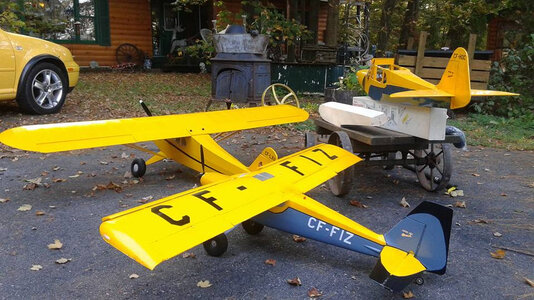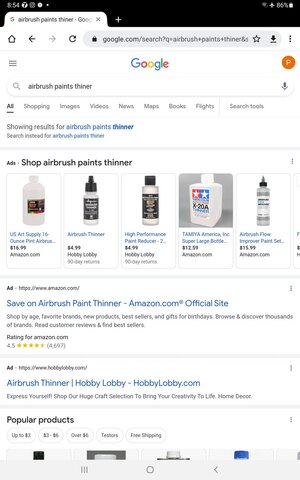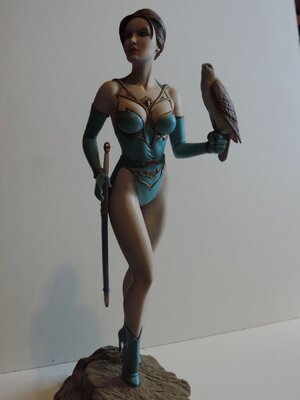I have been reading information on the internet with regards to how to thin acrylic paint so that it can be used in an airbrush. I know there are paints designed to be used in an airbrush without dilution, but they are expensive and you don't get a lot of paint. So, I was wondering is it ok just to use distilled water to dilute craft acrylic paint or must I use a thinner that is designed for this purpose?
You are using an out of date browser. It may not display this or other websites correctly.
You should upgrade or use an alternative browser.
You should upgrade or use an alternative browser.
How do you thin Acrylic paint so that it can be used in an airbrush
- Thread starter Jack Sparrow
- Start date
- Watchers 18
If I were you I'd avoid craft paint and go for some of the good stuff for airbrushing. I find Tamiya and Vallejo acrylic paints work great in the airbrush and usually don't require thinning. Airbrushes can be finicky, and I find when I try to use older paints or paints not designed for airbrushing, I run into issues with clogging or over diluting, which makes the paint run. I must confess I've never tried to airbrush craft paint, but that's because it always seems too thick to me. I do, however, use it for brush painting quite a bit.
That being said, when I do dilute acrylic I usually just add a couple of drops of water to the airbrush reservoir and mix it before spraying. I'd recommend practicing on some paper before trying the model. Good luck.
That being said, when I do dilute acrylic I usually just add a couple of drops of water to the airbrush reservoir and mix it before spraying. I'd recommend practicing on some paper before trying the model. Good luck.
Thank you. You have given me a lot to think about.If I were you I'd avoid craft paint and go for some of the good stuff for airbrushing. I find Tamiya and Vallejo acrylic paints work great in the airbrush and usually don't require thinning. Airbrushes can be finicky, and I find when I try to use older paints or paints not designed for airbrushing, I run into issues with clogging or over diluting, which makes the paint run. I must confess I've never tried to airbrush craft paint, but that's because it always seems too thick to me. I do, however, use it for brush painting quite a bit.
That being said, when I do dilute acrylic I usually just add a couple of drops of water to the airbrush reservoir and mix it before spraying. I'd recommend practicing on some paper before trying the model. Good luck.
Hi Jack,
Over the years I tried different manufacturers model paints for airbrushing but not craft paints. After some frustration I eventually settled on Vallejo Model Air acrylic paints. What a difference! Easy to use, easy cleanup, easy to dispense from the paint dropper bottle, large colour range and a fine even spray. I don’t use anything else now.
The trick to airbrushing is to get a consistency that looks like 2% milk. Vallejo can be airbrushed straight from the bottle but after some experimentation I have found I use the following “mix”. For every ten drops (yes I count them ) of Vallejo Model Air I add one or two drops of Vallejo airbrush thinner. To reduce dry tip on the needle and nozzle area I often add one drop of Vallejo Flow Improver. All put directly into the cup then I mix well using a very thin stir stick made of plastic.
) of Vallejo Model Air I add one or two drops of Vallejo airbrush thinner. To reduce dry tip on the needle and nozzle area I often add one drop of Vallejo Flow Improver. All put directly into the cup then I mix well using a very thin stir stick made of plastic.
It took a little getting used to and I adjust slightly if the paint from the bottle seems to thicken as you reduce, from use, the amount left. I am particular in making sure the thinner and flow improver is from Vallejo. You may get advice and opinions from many other modellers ranging from “use water”, “use Windex” and so on. My feelings are to use the same make of thinners for the same make of paints. That way you are following the paint manufacturers recommendations.
Make sure it’s Model Air if you go with Vallejo.
Hope this gives you some thoughts.
Over the years I tried different manufacturers model paints for airbrushing but not craft paints. After some frustration I eventually settled on Vallejo Model Air acrylic paints. What a difference! Easy to use, easy cleanup, easy to dispense from the paint dropper bottle, large colour range and a fine even spray. I don’t use anything else now.
The trick to airbrushing is to get a consistency that looks like 2% milk. Vallejo can be airbrushed straight from the bottle but after some experimentation I have found I use the following “mix”. For every ten drops (yes I count them
It took a little getting used to and I adjust slightly if the paint from the bottle seems to thicken as you reduce, from use, the amount left. I am particular in making sure the thinner and flow improver is from Vallejo. You may get advice and opinions from many other modellers ranging from “use water”, “use Windex” and so on. My feelings are to use the same make of thinners for the same make of paints. That way you are following the paint manufacturers recommendations.
Make sure it’s Model Air if you go with Vallejo.
Hope this gives you some thoughts.
Great, thanks. Definitely valuable information. My issue is getting enough paint to complete my model and the typical airbrush paints only come in small quantities. I would probably need 10 times what those little bottles contain(this is just a guesstimate). So, my workaround, if it works, is to buy craft paint and dilute it with what I thought was going to be distilled water, but upon further reflection, I would use an appropriate thinner. I'll definitely practice on something before actually using it on the Bismarck.Hi Jack,
Over the years I tried different manufacturers model paints for airbrushing but not craft paints. After some frustration I eventually settled on Vallejo Model Air acrylic paints. What a difference! Easy to use, easy cleanup, easy to dispense from the paint dropper bottle, large colour range and a fine even spray. I don’t use anything else now.
The trick to airbrushing is to get a consistency that looks like 2% milk. Vallejo can be airbrushed straight from the bottle but after some experimentation I have found I use the following “mix”. For every ten drops (yes I count them) of Vallejo Model Air I add one or two drops of Vallejo airbrush thinner. To reduce dry tip on the needle and nozzle area I often add one drop of Vallejo Flow Improver. All put directly into the cup then I mix well using a very thin stir stick made of plastic.
It took a little getting used to and I adjust slightly if the paint from the bottle seems to thicken as you reduce, from use, the amount left. I am particular in making sure the thinner and flow improver is from Vallejo. You may get advice and opinions from many other modellers ranging from “use water”, “use Windex” and so on. My feelings are to use the same make of thinners for the same make of paints. That way you are following the paint manufacturers recommendations.
Make sure it’s Model Air if you go with Vallejo.
Hope this gives you some thoughts.
Jack I always use a Thinner as these have retarder in them which not only helps flow out on the surface but also helps stop the paint drying on the tip which can be an issue with Acrylics.I have even used Tamiya Acrylic thinner with art acrylics for brush painting with fantastic results.I wouldn't try these in an airbrush though as the pigments aren't generally ground fine enough for the small tips
Kind Regards
Nigel
Kind Regards
Nigel
Thank you for the information. When you mention art acrylics, are you referring to the paint that comes in tubes?Jack I always use a Thinner as these have retarder in them which not only helps flow out on the surface but also helps stop the paint drying on the tip which can be an issue with Acrylics.I have even used Tamiya Acrylic thinner with art acrylics for brush painting with fantastic results.I wouldn't try these in an airbrush though as the pigments aren't generally ground fine enough for the small tips
Kind Regards
Nigel
Yes Jack,I am.It takes numerous thin coats but even Basswood can end up with a glass smooth surface if you desire using these thinned
Kind Regards
Nigel
Kind Regards
Nigel
I was thinking about this again today and found myself wondering if you'd consider using rattle-can enamel paints. They are easier to use than an airbrush and are likely more affordable for a large project and give good, consistent coverage with little hassle.
From my understanding Vallejo has 2 lines of paint. 1 for brush work and the other is for airbrush. Double check
If you wish rattle can paints can be decanted from the can and used in an airbrush. Plenty of you tube videos show how to do that. Also videos of this on the fine scale modeling site. As for craft store acrylics, in general they are much thicker and the pigments have not been ground as fine. However there are videos on you tube on how to prepare and use these acrylics in an airbrush. I have never done so.I was thinking about this again today and found myself wondering if you'd consider using rattle-can enamel paints. They are easier to use than an airbrush and are likely more affordable for a large project and give good, consistent coverage with little hassle.
Jack: You can relate to this Canadian solution eh?
I used this formula to paint model airplanes using acrylic paint. It may need some adjustments, but for large surfaces it's very affordable. I used Home Hardware (Canada) acrylic paint to produce Cub Yellow. The hardware store scanned some Monokote covering to mix the desired base colour.
Acrylic Thinner Mixture Procedure
Distilled water 38 ml
91% isopropyl alcohol 22 ml
Flow-aid 1 ml (Liquitex)
Fluid retarder 1 ml (Golden Retarder)
25 psi on compressor
Mixing Proportions
1 part paint (acrylic Home Hardware)
1 part thinner mix
Fluid retarder and flow-aid are available at craft stores; eg. Michaels
CF-FIZ is a foam model painted with my mixture

I used this formula to paint model airplanes using acrylic paint. It may need some adjustments, but for large surfaces it's very affordable. I used Home Hardware (Canada) acrylic paint to produce Cub Yellow. The hardware store scanned some Monokote covering to mix the desired base colour.
Acrylic Thinner Mixture Procedure
Distilled water 38 ml
91% isopropyl alcohol 22 ml
Flow-aid 1 ml (Liquitex)
Fluid retarder 1 ml (Golden Retarder)
25 psi on compressor
Mixing Proportions
1 part paint (acrylic Home Hardware)
1 part thinner mix
Fluid retarder and flow-aid are available at craft stores; eg. Michaels
CF-FIZ is a foam model painted with my mixture

Last edited:
I have successfully used rattle can enamels on several projects. Thins coats are required to avoid runs. But they must be used outside or in a very well ventilated area because their lingering smell is terrible. Where I live that limits their use to spring through early fall when temperatures are above 50 F.
- Joined
- Jan 21, 2022
- Messages
- 397
- Points
- 238

I use Tamiya acrylic paint only and I thin with Tamiya acrylic lacquer thinner it works great! the 3 mil bottles of [paint just add the thinner to the first ring on the neck of the bottle and load your airbrushI have been reading information on the internet with regards to how to thin acrylic paint so that it can be used in an airbrush. I know there are paints designed to be used in an airbrush without dilution, but they are expensive and you don't get a lot of paint. So, I was wondering is it ok just to use distilled water to dilute craft acrylic paint or must I use a thinner that is designed for this purpose?
I believe so. THe model air paint is the one that they recommend for airbrushingFrom my understanding Vallejo has 2 lines of paint. 1 for brush work and the other is for airbrush. Double check
Looks great.Jack: You can relate to this Canadian solution eh?
I used this formula to paint model airplanes using acrylic paint. It may need some adjustments, but for large surfaces it's very affordable. I used Home Hardware (Canada) acrylic paint to produce Cub Yellow. The hardware store scanned some Monokote covering to mix the desired base colour.
Acrylic Thinner Mixture Procedure
Distilled water 38 ml
91% isopropyl alcohol 22 ml
Flow-aid 1 ml (Liquitex)
Fluid retarder 1 ml (Golden Retarder)
25 psi on compressor
Mixing Proportions
1 part paint (acrylic Home Hardware)
1 part thinner mix
Fluid retarder and flow-aid are available at craft stores; eg. Michaels
CF-FIZ is a foam model painted with my mixture
View attachment 297001
yup. that's what i did but i may try out my own thinner since i need a lot.
this Bismarck project is turning into quite the monster.
- Joined
- Dec 14, 2021
- Messages
- 151
- Points
- 113

I also only use vallejo model air, a little goes a long way! I find some colours are more prone to blockages than others so now always add a few drops of flow improver (but from reading the above think I'll try thinners next). Instead of mixing flow/improver/thinners with the paint in the airbrush cup, I collect empty vaping liquid bottles, give them a good wash and make up the mix in these; it allows me to give them a good shake before using the mix and my sense is that I have far fewer blockages than mixing in the cup. I can then keep leftovers for later. I use those little ziplok bags to keep the original and mixed together so I know what's what. Obviously any small bottle would do, including empty paint bottles, or you could be more scientific and just add the thinning agent to a new bottle from the outset.







